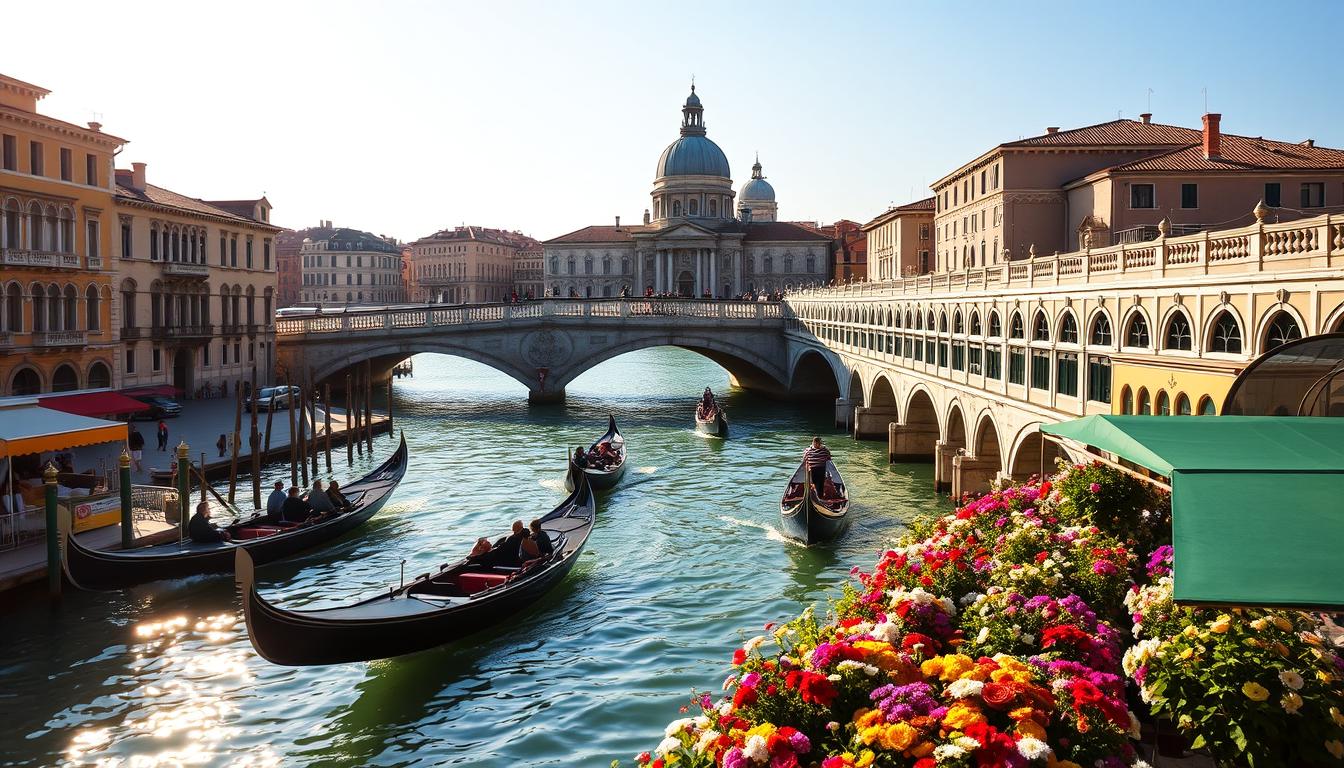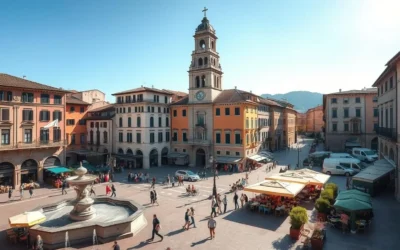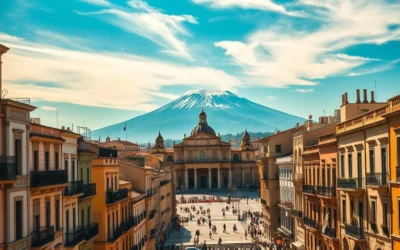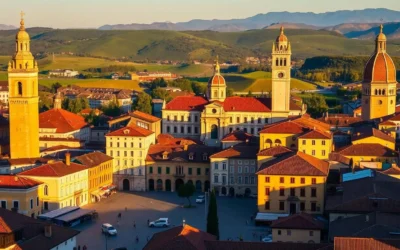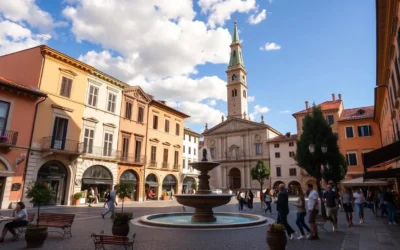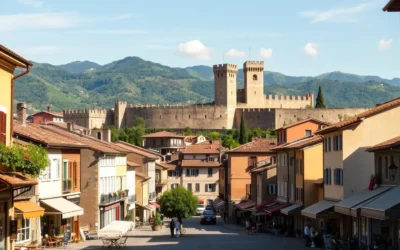Did you know that November is one of the most affordable and least crowded times to visit this stunning destination? With fewer tourists and lower rates, it’s an ideal time to experience the charm of this historic city.
Planning your trip around the local climate can make all the difference. From the unique phenomenon of acqua alta to the vibrant celebrations of Carnevale, each month offers something special. Understanding the weather patterns ensures you’ll enjoy every moment.
This guide will help you navigate the seasonal trends, so you can choose the best time to visit. Whether you’re drawn to cultural festivals or quieter streets, we’ll provide insights to enhance your travel experience.
Understanding Venice’s Unique Climate and Seasonal Patterns
Understanding the unique climate of this historic city can transform your travel experience. The Mediterranean influence plays a key role in shaping its weather patterns, creating a dynamic environment that changes with each season.
Venice’s Mediterranean Weather Influence
The Adriatic Sea and the city’s intricate canal system create a micro-climate that’s both fascinating and unpredictable. Summers are warm and humid, while winters bring cooler temperatures and frequent rain. This blend of elements makes every month unique.
Seasonal Temperature and Rainfall Trends
Spring and fall offer mild weather, with comfortable temperatures and fewer tourists. Summer, however, can be hot and crowded, with rain showers occasionally cooling things down. Winter is colder and wetter, with the added challenge of acqua alta, or high water, which can flood parts of the city.
Understanding these patterns is essential for planning your time here. Whether you’re drawn to sunny days or quieter streets, knowing what to expect ensures a smoother experience. Keep in mind that climate change is making these trends less predictable, so flexibility is key.
Assessing Weather Trends for an Ideal Trip
Exploring the weather patterns can significantly enhance your travel experience. From temperature shifts to flood risks, understanding these trends ensures you’re prepared for any surprises.
Typical Temperature Variations
The temperature in this historic city varies widely throughout the year. Summers are warm, with July and August reaching highs of 32°C. Winters are cooler, with January lows around 3°C. Spring and fall offer mild weather, perfect for outdoor activities.
Here’s a breakdown of average temperatures by month:
| Month | High (°C) | Low (°C) |
|---|---|---|
| January | 13 | 3 |
| February | 14 | 3 |
| March | 17 | 6 |
| April | 20 | 8 |
| May | 24 | 13 |
| June | 29 | 17 |
| July | 32 | 19 |
| August | 30 | 18 |
| September | 27 | 16 |
| October | 23 | 12 |
| November | 18 | 8 |
| December | 15 | 4 |
These variations can impact your day-to-day plans. For example, summer heat might make midday tours less comfortable, while cooler months are ideal for walking tours.
Flood Risks and Acqua Alta
One unique weather phenomenon here is acqua alta, or high water. This flooding typically occurs from October to January, affecting parts of the city. While it can disrupt outdoor activities, it’s also a fascinating natural event to witness.
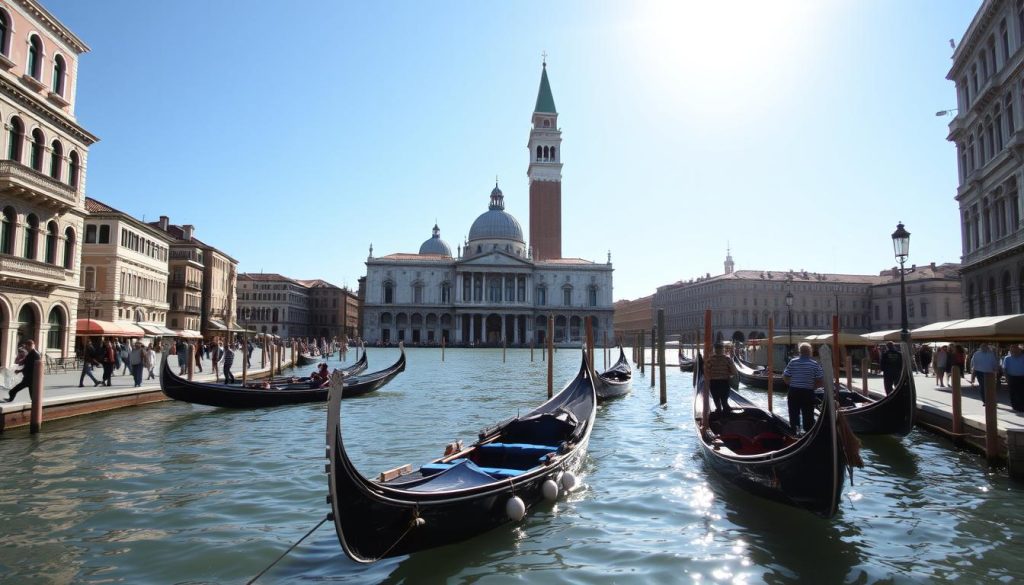
To manage this, plan indoor activities like museum visits or café stops during flood-prone months. Many tour operators adjust schedules to accommodate these conditions, ensuring you still have a memorable experience.
By understanding these weather trends, you can balance your itinerary for a relaxed and enjoyable trip. Whether you’re exploring during sunny days or navigating occasional rain, preparation is key to making the most of your holiday.
Venice, Italy: Best Months for a Weather-Savvy Trip
Choosing the right time to visit can make or break your experience. The season you pick shapes everything from the weather to the number of tourists you’ll encounter. Whether you prefer bustling streets or quieter moments, understanding peak and shoulder seasons is key.
Comparing Peak and Shoulder Seasons
Peak season, typically from May to September, brings vibrant energy and long summer evenings. However, it also means higher prices and larger crowds. On the other hand, shoulder seasons like spring and fall offer milder weather and fewer tourists, making it easier to explore at your own pace.
| Aspect | Peak Season | Shoulder Season |
|---|---|---|
| Weather | Warm, humid | Mild, comfortable |
| Crowds | High | Low to moderate |
| Costs | Higher | More affordable |
| Events | Festivals, lively atmosphere | Local traditions, quieter vibe |
Balancing Weather with Tourist Crowds
Finding the perfect balance between ideal weather and manageable crowds is crucial. Summer’s warmth is inviting, but the sheer number of visitors can be overwhelming. Shoulder seasons provide a more relaxed experience, with crisp air and fewer people.
For example, November offers a unique charm with cooler temperatures and affordable accommodations. It’s also a great time to enjoy local events without the hustle and bustle of peak months.
Ultimately, the best time to visit depends on your preferences. Whether you thrive in the energy of peak season or prefer the tranquility of shoulder months, both options have their perks. Plan wisely to create a travel experience that’s uniquely yours.
Exploring Seasonal Events and Festivals in Venice
Immerse yourself in the vibrant cultural tapestry of this historic destination. The city comes alive with festivals and events that showcase its rich traditions and lively spirit. From masked balls to art exhibitions, there’s always something to captivate your imagination.
Carnevale and the Biennale Experience
Carnevale is one of the most iconic festivals in the world. Held in February, it transforms the streets into a stage for elaborate costumes and masked parades. The event dates back centuries, offering a glimpse into the city’s history and creativity.
Another must-see is the Biennale, a prestigious art and architecture event that takes place every two years. From June to November, it attracts artists and visitors from around the globe. The exhibitions are spread across various venues, including the Giardini and Arsenale, making it a highlight of the cultural calendar.
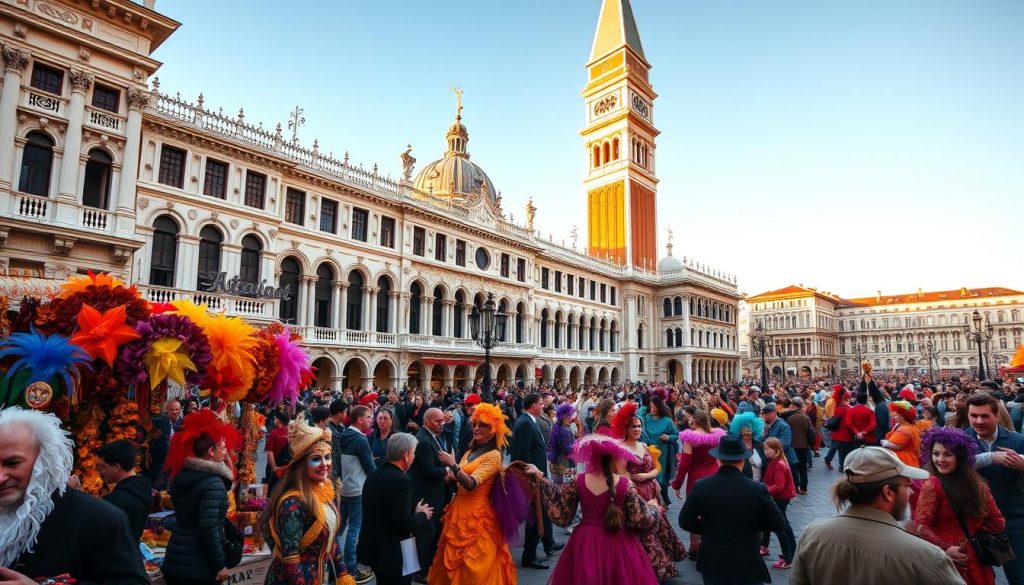
Festa del Redentore and Local Celebrations
The Festa del Redentore, celebrated on the third weekend of July, is a time of joy and reflection. This festival commemorates the end of a plague in the 16th century. The highlight is a stunning fireworks display over the Grand Canal, lighting up the evening sky.
Local celebrations also include the Feast of the Madonna della Salute in November. This event features processions and traditional food, offering a deeper connection to the city’s heritage. These festivals not only entertain but also provide a unique experience for visitors.
Here’s a quick guide to some of the key festivals and their timing:
| Festival | Month | Highlights |
|---|---|---|
| Carnevale | February | Costumes, masks, parades |
| Biennale | June-November | Art and architecture exhibitions |
| Festa del Redentore | July | Fireworks, boat processions |
| Madonna della Salute | November | Processions, traditional food |
Attending these festivals can elevate your trip. To make the most of your experience, plan ahead. Book accommodations early, especially during peak season. Balance your itinerary by combining festival activities with visits to museums and quieter spots.
“The magic of these events lies in their ability to bring people together, celebrating the city’s past and present.”
Whether you’re drawn to the grandeur of Carnevale or the serenity of local celebrations, these events offer a memorable experience. Embrace the energy and let the city’s festivals guide your journey.
Navigating Peak vs Off-Peak Travel Seasons
Traveling during quieter months can transform your experience. Whether you’re looking to save money or avoid crowds, timing your visit wisely can make all the difference. Let’s explore how off-peak travel can enhance your trip.
Budget-Friendly and Off-Season Advantages
One of the biggest perks of traveling during off-peak months is the cost savings. Hotel rates and airfare are significantly lower, making it easier to stick to your budget. For example, November and early spring often see prices drop by up to 30% compared to peak season.
Fewer tourists also mean more availability for accommodations and attractions. You’ll have a better chance of securing your preferred hotel or booking a guided tour without the hassle of long waits. This relaxed pace allows you to enjoy the city at your own rhythm.
Additionally, off-season travel often leads to more authentic local experiences. With fewer visitors, you’re more likely to interact with locals and discover hidden gems that are overlooked during busier months.
Crowd Avoidance Strategies
If you’re planning a trip during peak season, there are still ways to avoid the crowds. Start your day early by visiting popular attractions as soon as they open. This not only helps you beat the rush but also allows you to enjoy these sites in a more peaceful setting.
Another strategy is to explore lesser-known areas. While iconic landmarks are a must-see, venturing off the beaten path can provide a refreshing change of pace. You’ll often find quieter streets and charming spots that are just as captivating.
“The beauty of off-peak travel lies in its ability to offer a more intimate and relaxed experience.”
Finally, consider scheduling your visit to key attractions during quieter times, such as weekday evenings. This approach ensures you can fully appreciate these sites without the distraction of large crowds.
By planning your trip around these strategies, you can enjoy a more enjoyable and stress-free experience. Whether you’re exploring during peak or off-peak seasons, a little preparation goes a long way.
Weather-Savvy Planning Tips for Your Journey
Planning a trip to a destination with unpredictable weather? Here’s how to stay prepared and make the most of your journey. Whether you’re visiting in spring or fall, understanding the climate and packing smartly can enhance your experience.
Packing Essentials for Variable Weather
When preparing for your trip, layering is key. Sudden temperature shifts are common, so pack lightweight clothes that can be easily added or removed. A waterproof jacket and a collapsible umbrella are must-haves for unexpected rain.
Here’s a quick packing list to ensure you’re ready for any weather:
- Lightweight layers (e.g., cardigans, scarves)
- Waterproof jacket or poncho
- Comfortable walking shoes
- Sun hat and sunglasses for sunny days
- Small backpack for day trips
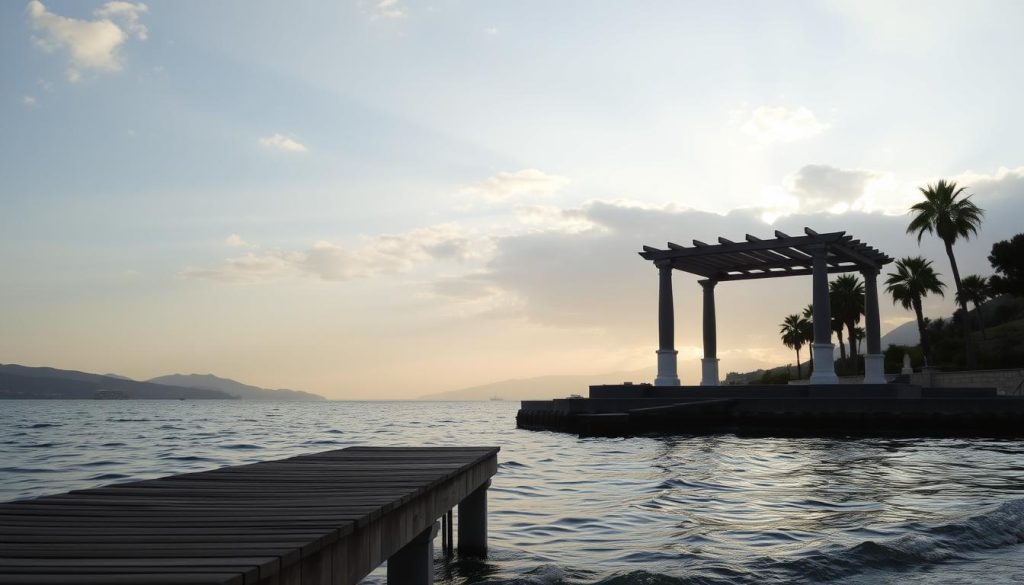
Flexible Itineraries and Backup Plans
Creating a flexible schedule is crucial for a stress-free travel experience. If rain or heat disrupts your plans, having indoor activities like museum visits or café stops can save the day. Check the forecast each morning to adjust your itinerary accordingly.
For day trips or tours, consider options that work well in both spring and fall. These seasons offer milder weather, making outdoor exploration more enjoyable. Always have a backup plan for extreme conditions.
“A well-prepared traveler checks the forecast and plans for flexibility, ensuring a smooth journey regardless of the weather.”
By following these tips, you’ll be ready to handle any climate changes and enjoy your trip to the fullest. Remember, a little preparation goes a long way in making your travel experience unforgettable.
Making the Most of Venice’s Indoor and Outdoor Attractions
Discover how to make the most of both indoor and outdoor highlights. Balancing these activities ensures a well-rounded experience and lets you enjoy the city in any season.
On rainy or cold days, explore the museum scene. The Gallerie dell’Accademia showcases Venetian masterpieces, while the Peggy Guggenheim Collection features modern art. These spots are perfect for escaping the climate while soaking in culture.
When the weather is clear, head outdoors. A canal tour offers stunning views of historic palaces, while a leisurely walk through the city reveals hidden gems. Timing is key—early mornings or late afternoons are ideal to avoid the midday heat in summer or the chill of winter.
Different seasons favor specific attractions. Summer is perfect for outdoor events like the Festa del Redentore, while winter invites cozy museum visits. Plan your itinerary to match the climate and weather conditions.
Combine indoor and outdoor activities for a balanced experience. Pair a morning at the Doge’s Palace with an afternoon stroll along the Grand Canal. This approach lets you enjoy the city’s diversity without feeling rushed.
Don’t forget to savor local food along the way. Stop for cicchetti, small bites that highlight Venetian cuisine, or enjoy a seafood risotto at a canal-side restaurant. These culinary stops add flavor to your travel adventure.
Using a reliable guide can enhance your experience. They’ll help you navigate the city’s many attractions and hidden spots, ensuring you make the most of your time.
“Balancing indoor and outdoor activities ensures you experience the city’s charm in every season.”
By aligning your itinerary with the season, you’ll maximize your enjoyment. Whether you’re exploring museums or cruising the canals, a thoughtful plan ensures a memorable travel experience.
Regional Weather Variations and Italy’s Microclimates
Italy’s diverse landscapes create unique weather patterns across the country. From the snowy Alps in the north to the sunny coasts of the south, each area offers a distinct climate. Understanding these differences can help you plan a more enjoyable trip.

Comparing Venice to Other Italian Regions
Venice’s weather is shaped by its location on the Adriatic Sea, with mild winters and humid summers. In contrast, Rome and Florence experience hotter summers, often reaching over 30°C. Milan, in the north, has cooler winters with occasional snowfall, while southern regions like Sicily enjoy warm temperatures year-round.
Here’s a quick comparison of average weather conditions in key Italian cities:
| City | Summer High (°C) | Winter Low (°C) | Rainfall (mm) |
|---|---|---|---|
| Venice | 30 | 3 | 750 |
| Rome | 32 | 5 | 800 |
| Florence | 34 | 4 | 850 |
| Milan | 31 | 0 | 900 |
These variations highlight how geography influences climate. The Alps bring cooler weather to the north, while the Mediterranean Sea warms the south. This diversity makes Italy a fascinating country to explore, no matter the season.
Climate Change and Its Impact
Climate change is affecting Italy’s weather patterns, leading to more extreme conditions. Venice, for example, is experiencing more frequent acqua alta events due to rising sea levels. In the south, hotter summers and prolonged droughts are becoming common.
These changes make it essential to plan your travel carefully. Checking local forecasts and using a reliable guide can help you navigate these challenges. For instance, visiting northern regions in spring or fall offers milder weather and fewer crowds.
Practical Tips for Travelers
To make the most of your trip, consider the following tips:
- Visit northern Italy in spring or fall for comfortable temperatures.
- Explore southern regions in late spring or early summer to avoid extreme heat.
- Pack layers to adapt to sudden weather changes.
- Plan indoor activities like museum visits for rainy days.
By understanding regional climate differences, you can create a well-rounded travel plan. Whether you’re exploring historic cities or relaxing on sunny coasts, Italy’s diverse weather ensures a memorable experience.
Local Insights and Insider Travel Tips
Unlock the secrets of this enchanting destination with insider tips from locals. While iconic landmarks are a must-see, the true magic lies in the hidden corners and lesser-known spots that most tourists overlook. A good guide can help you uncover these gems, making your travel experience unforgettable.
Hidden Gems and Off-the-Beaten-Path Advice
Start your exploration by wandering through quieter neighborhoods. The streets of Cannaregio and Dorsoduro are perfect for discovering authentic local life. These areas are less crowded, allowing you to enjoy the city’s charm without the hustle and bustle.
For a unique experience, visit the Scuola Grande di San Rocco. This museum is often overlooked but houses stunning works by Tintoretto. Another hidden gem is the Fondazione Querini Stampalia, a peaceful retreat with beautiful gardens and art collections.
Timing is key to enhancing your trip. Early mornings and late evenings are ideal for exploring popular spots like St. Mark’s Basilica without the crowds. This also gives you a chance to capture stunning photos in soft, natural light.
“The best way to experience a place is to see it through the eyes of those who call it home.”
Don’t miss out on local festivals and food experiences. Events like the Festa della Sensa offer a glimpse into the city’s traditions. For authentic flavors, try cicchetti at small bacari (wine bars) or enjoy a seafood risotto at a canal-side restaurant.
Here are some actionable tips to make your travel more enriching:
- Explore quieter neighborhoods like Cannaregio and Dorsoduro.
- Visit lesser-known museums such as the Scuola Grande di San Rocco.
- Time your visits to popular attractions for early mornings or late evenings.
- Engage with locals to discover hidden gems and authentic experiences.
By balancing popular attractions with spontaneous discoveries, you’ll create a trip that’s uniquely yours. These insights, rooted in local expertise, ensure a memorable and enriching experience.
Conclusion
Planning your journey around the right seasons can transform your travel experience. Aligning your trip with favorable weather ensures you enjoy fewer crowds and cost savings. Spring and fall offer ideal conditions, making them the best time visit for a relaxed and authentic experience.
Using this guide helps you navigate local events and hidden gems. Whether you’re exploring museums or taking a scenic tour, understanding the weather trends ensures a smooth journey. Strategic planning allows you to capture the essence of the city without the hassle.
Start preparing now for an unforgettable holiday. With the right approach, every day of your trip will be filled with memorable moments. Happy travels!
The above is subject to change.
Check back often to TRAVEL.COM for the latest travel tips and deals.
Here are some Tours & Sightseeing suggestions that might pique your interests!
